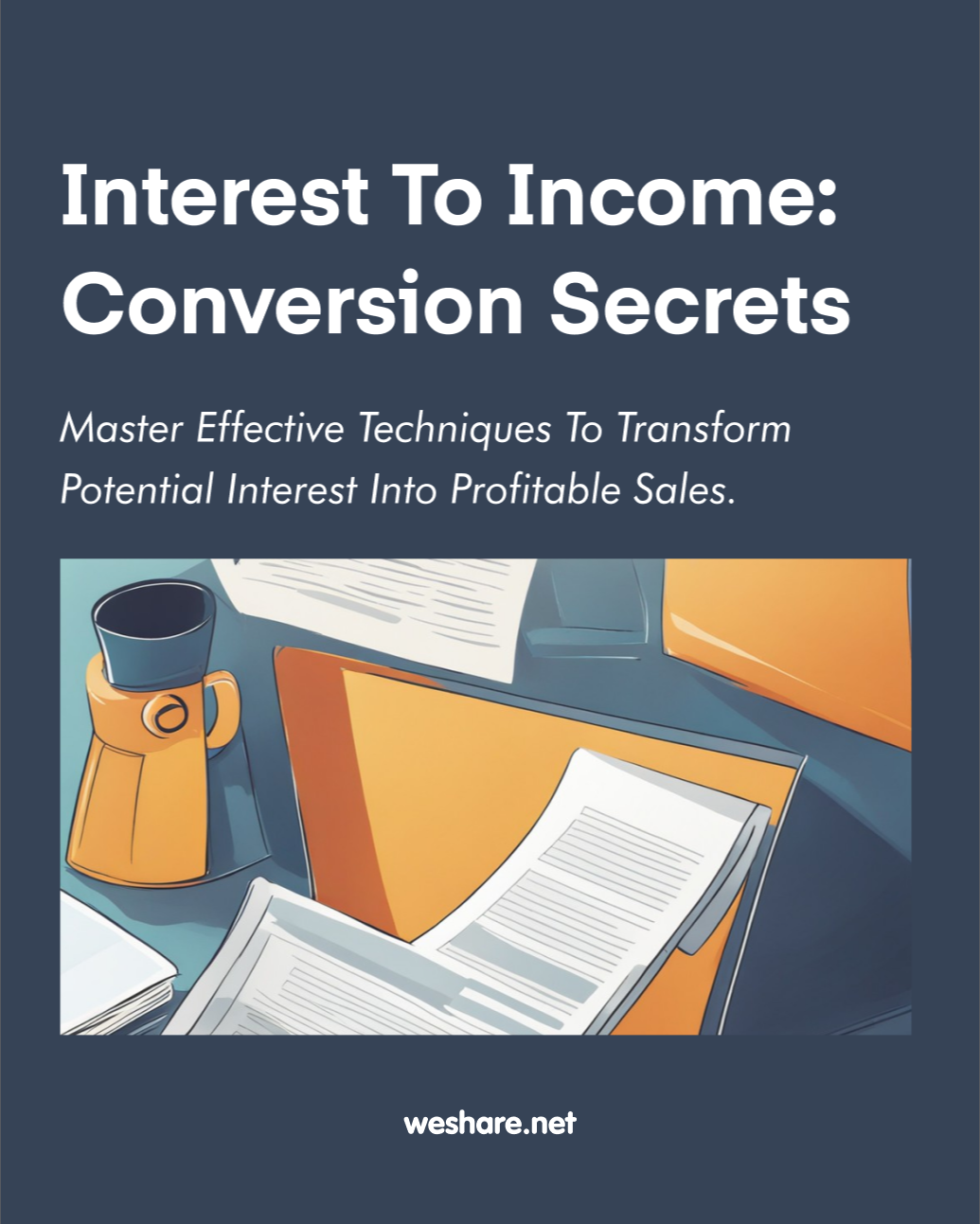Provided by Weshare.net, your go-to resource for the best tips and information about sales.
Welcome to the world of sales! As a new sales representative or an entry-level professional, mastering the fundamentals of sales is crucial for your success. This tip sheet is designed to guide you through the essential aspects of the sales process, communication skills, and basic strategies. Let’s dive in!
Understanding the Sales Process
Sales is a multifaceted discipline that goes beyond mere persuasion. It’s a process that involves understanding client needs, offering tailored solutions, and forging lasting relationships. To excel in sales, it’s crucial to master each stage of this process. This guide provides a comprehensive checklist and specific instructions to enhance your sales strategy, along with valuable tips to really elevate your approach.
Checklist for the Sales Process
- Understanding Customer Needs
- Conduct market research to understand target demographics.
- Prepare open-ended questions to uncover client needs.
- Listen actively during client interactions.
- Document client responses for future reference.
- Tailoring Your Pitch
- Match product features with customer needs identified.
- Develop a customizable sales pitch template.
- Use storytelling to make your pitch more engaging.
- Prepare visual aids and demos if applicable.
- Handling Objections
- Anticipate common objections and prepare responses.
- Train in empathy and active listening skills.
- Create a FAQ document for quick reference.
- Practice objection handling with role-play exercises.
- Closing the Deal
- Recognize buying signals from the client.
- Use trial closes to gauge readiness.
- Be clear about the next steps and follow-up procedures.
- Develop a sense of urgency without being pushy.
Specific Instructions with Tips
Identifying Customer Needs
- How to Ask Open-Ended Questions:
- Script Example: “What challenges are you currently facing with [their industry-specific issue]?”
- Tip: Tailor your questions based on preliminary research about the client or their industry.
Presenting Your Solution
- Customizing Your Pitch:
- Template Example:
Introduction: [Greet and relate to the client]
Needs Addressed: [List the needs identified]
Solution: [Your product/service and how it solves those needs]
Benefits: [Specific benefits tailored to the client] - Tip: Use real-life success stories or case studies to illustrate your points.
- Template Example:
Handling Objections
- Effective Response Strategies:
- Script Examples:
- Client: “It’s too expensive.”
- You: “I understand your concern about the budget. Let’s explore how the ROI justifies the initial investment.”
- Tip: Always validate their concerns before offering a solution.
- Script Examples:
Closing the Deal
- Asking for the Sale:
- Script Example: “Based on our discussion, it seems like [Product/Service] is a good fit for your needs. Shall we proceed with the next steps?”
- Tip: Be confident but not aggressive. It’s about guiding, not pushing.
Remember, sales is an evolving field, and staying updated with the latest trends and techniques is crucial. These guidelines provide a foundation, but always be ready to adapt and personalize your approach based on your client and situation.
Effective Communication Skills in Sales
Effective communication is crucial in sales. It’s about connecting with your audience, understanding their needs, and presenting your message in a way that resonates with them. Here’s a checklist and specific instructions to enhance your communication skills, complete with tips and templates for practical application.
Checklist for Effective Sales Communication
- Active Listening
- Focus on the speaker.
- Avoid interrupting.
- Summarize their points for clarity.
- Clear Messaging
- Use simple, concise language.
- Avoid industry jargon.
- Tailor your message to the customer’s understanding level.
- Positive Language
- Emphasize solutions and benefits.
- Reframe negative situations positively.
- Avoid words like “can’t,” “won’t,” or “don’t.”
Specific Instructions and Tips
Active Listening
Active listening is more than just hearing words; it’s about understanding the message behind them. Here are specific tips:
- Maintain Eye Contact: This shows you’re focused and engaged.
- Nod and Smile: Non-verbal cues indicate you’re following along.
- Repeat or Paraphrase: This ensures you’ve understood correctly. For example, say, “So, what you’re saying is…”
- Ask Open-Ended Questions: Encourage them to share more. For instance, “What are your main concerns about…?”
Clear Messaging
Your message should be easy to understand and remember.
- Be Concise: Get to the point quickly. Avoid long-winded explanations.
- Use Analogies: Relate complex ideas to everyday concepts. For example, “Think of our product like a Swiss Army knife—it has multiple tools for different tasks.”
- Tailor Your Language: Adjust your vocabulary to match the customer’s level of expertise.
Positive Language
The way you phrase your messages can dramatically impact your customer’s perception.
- Focus on What You Can Do: Instead of saying “We can’t deliver by Monday,” try “The earliest we can deliver is Tuesday.”
- Highlight Benefits: Instead of focusing on features, talk about how your product makes life easier. For instance, “Our software automates tedious tasks, giving you more time for creative work.”
- Use Encouraging Words: Phrases like “certainly,” “definitely,” and “absolutely” add positivity to your conversations.
Templates and Scripts
Active Listening Script
Customer: I’m worried about the cost. Salesperson: It sounds like budget is a major concern for you. What specific budget constraints are you dealing with?
Clear Messaging Template
Our [Product/Service] is like [Simple Analogy], it helps you [Benefit] without [Common Problem].
Positive Language Example
Instead of: “This model lacks the feature of X.” Say: “This model offers Y, which enhances efficiency, although it doesn’t include X.”
Incorporating these communication skills into your sales approach can significantly improve your interactions and outcomes. Remember, it’s not just what you say but how you say it that counts.
Basic Strategy
Creating a robust sales strategy is crucial for any business looking to thrive in a competitive marketplace. This guide will expand upon the basic strategy elements, offering a detailed checklist, specific instructions, and valuable tips to enhance your approach. By incorporating these insights, you can develop a strategy that not only aligns with your goals but also resonates with your target audience.
Basic Strategy Overview
- Know Your Product
- Checklist:
- Familiarize yourself with all product features.
- Understand the benefits specific to different customer segments.
- Stay updated on product updates or changes.
- Instructions:
- Allocate time weekly to review product materials.
- Engage in regular training sessions.
- Use the product yourself to gain first-hand experience.
- Tips:
- Create a product FAQ for quick reference.
- Share product success stories to highlight real-world applications.
- Checklist:
- Understand Your Audience
- Checklist:
- Identify key customer segments.
- Research customer needs, challenges, and preferences.
- Continuously gather feedback from current customers.
- Instructions:
- Conduct market research to understand your audience better.
- Create buyer personas to tailor your approach.
- Use CRM tools to track customer interactions and preferences.
- Tips:
- Engage in social listening to monitor customer opinions and trends.
- Regularly review customer feedback to adapt your strategy.
- Checklist:
- Follow-Up
- Checklist:
- Establish a systematic follow-up process.
- Personalize follow-up messages.
- Schedule follow-ups at appropriate intervals.
- Instructions:
- Use email automation tools for timely follow-ups.
- Personalize communication based on previous interactions.
- Set reminders for follow-up calls or emails.
- Tips:
- Follow-up with a value-add, such as a useful resource or piece of information.
- Show appreciation in your follow-ups, such as thanking them for their time.
- Checklist:
Additional Elements to Consider
- Competitor Analysis
- Understand what your competitors are doing and how your product stands out.
- Script for Competitive Differentiation:
- “Unlike [Competitor], our product offers [Unique Feature], which means [Benefit to Customer].”
- Value Proposition
- Clearly articulate why customers should choose your product.
- Template for Value Proposition:
- “Our [Product/Service] solves [Customer Problem] by providing [Key Benefit]. Unlike [Competitor], we offer [Unique Feature].”
- Sales Enablement Tools
- Utilize tools that can aid in sales efficiency and effectiveness.
- Suggestions:
- CRM software for customer management.
- Automation tools for email follow-ups.
- Analytics tools for performance tracking.
- Continuous Learning and Adaptation
- Stay informed about industry trends and adapt your strategy accordingly.
- Tips:
- Subscribe to industry newsletters and podcasts.
- Attend webinars and workshops.
- Building Relationships
- Focus on building long-term relationships, not just closing a sale.
- Strategies:
- Offer exceptional post-sale support.
- Engage customers through social media and community events.
- Measuring Success
- Set clear metrics to evaluate the effectiveness of your sales strategy.
- Key Metrics:
- Conversion rates.
- Customer acquisition cost.
- Customer lifetime value.
Wrapping Up
Implementing these strategies effectively requires dedication and a willingness to continuously learn and adapt. By focusing on these core areas and utilizing the provided checklists and templates, you can develop a sales strategy that not only achieves short-term goals but also builds a foundation for long-term success.
Weshare’s Team – We’re in love with words, videos and everything in between. Our passion for helping people manage a business is evident in every article. We’re happy to be there in every part of the way – from starting to growing a successful business.
We Also Reviewed
- 45+ Advertising Statistics That Will Blow Your Mind
- 33 CRM Statistics You Should Know
- 41+ Public Speaking Statistics You Should Know
- 35 Machine Learning Statistics You Should Know
- 34 Employee Burnout Statistics You Should Know
- 39+ Communication Statistics You Need To Know
- 37+ Cold Calling Statistics You Need To Know
- 21+ Entrepreneur Statistics You Should Know
- 35+ Contract Management Statistics You Should Know
- 37+ Zoom Statistics You Should Know
- 35+ Sales Training Statistics You Should Know About
- 75+ WordPress Statistics You Need to Know
- 41+ Startup Statistics You Need to Know
- 37+ Presentation Statistics You Need To Know
- 41+ Recruiting Statistics You Need to Know
- 23+ Apple Podcast Statistics You Should Know About
- 31+ Spotify Podcast Statistics You Should Know About
- 35+ Spotify Statistics You Should Know

